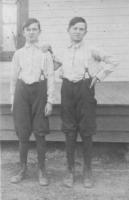
Greene County, Arkansas
The Matheny Twins

This is
my Grandpa and my Great-Uncle John. They were 13 years old in this picture.
Transcribed by: Sandy (Matheny) Hardin
Early farming sprouts big business- By Wade Quick Paragould Daily Press
Farmers cultivate hundreds of acres of land and contribute millions of dollars to Greene County's economy, but it wasn't always that way. Paragould, resident George Matheny remembers when Greene county's farmers practiced subsistence agriculture. Matheny,95, planted his first crop on a small farm in the Stonewall community. The crops Matheny grew--cotton, corn and soybeans-- remain an important part of Greene county's agriculture but only cotton's role has stayed the same. ""Cotton was the cash crop," Matheny said. The soybeans were used for pasture and the corn was livestock feed. Although the uses for the crops may have changed, the long hours needed to produce them haven't. Matheny said his day usually began when he fed his mules shortly after sunrise. After taking care of the livestock, Matheny ate his own breakfast. Then, he harnessed the team and headed for the fields. For the next several hours, Matheny kept his hands on the plow as the team plodded from one end of the field to the other. When noon finally arrived, Matheny headed home for dinner. After the meal, it was back to the fields until quitting time. "I usually got out a little after sunup and quit before sundown. Sometimes we would have a rush hour but hardly ever." Matheny said. While the rush may not have been constant, the work was. It had to be.
Government regulations limited the number of acres one could plant in cotton and prices were low. "One year it sold for 14 cents" a pound, Matheny said, adding that under President Franklin Roosevelt's administration cotton prices averaged "40 to 60 dollars a bale." To stretch his money, Matheny grew a sizable garden and his wife dried and canned all the produce she could. "We had plenty to eat such as it was," Matheny's wife Burley added. The couple also kept a cow so they could have milk and butter. A couple dozen chickens provided all the eggs they could use plus a few to sell. Surplus hogs also provided extra money. "After we got our meat we would sell the rest," Matheny said. He said his hog herd ranged from 15 to 40 head and that was "pretty typical." Matheny said hogs could be worth 15 cents a pound, but the price was often lower. In 1934, the price fell to four cents a pound, but for Matheny the price drop didn't really matter because he didn't have any hogs. "They all died. I didn't have a hog left." he said. However, Mathney had other ways of increasing his cash flow.
One of those was the timber industry. Matheny discovered cutting cross ties would allow him to pocket some cash and clear more farmland at the same time. Matheny said the modern practice of bulldozing timber into a pile and burning it is a wasteful way to clear land." I cleared all of mine with a chopping ax." he added. Despite taking a dim view of slash and burn agriculture, Matheny isn't entirely opposed to modern technology. His first tractor, purchased in the late 1950's, allowed him to almost triple the amount of land he farmed, but his income didn't rise proportionally. "I never understood why I couldn't make more money with a tractor than with a team," he remarked. Some technology came along too late to benefit Matheny who raised his final cotton crop in 1968. "That last crop I just couldn't hardly shoulder that old cotton sack," he said adding that cotton pickers weren't commonplace like they are today. Another change Matheny has seen is the increase in rice production. During his mid teens, Matheny first saw a field of rice. That was near McDougal, but the crop has spread through the region. However, Matheny said he doesn't think rice has ever been grown on the land he used to farm at Stonewall.
'I always thought it would ruin your land. I just never did think I'd like it on my place," Matheny explained. Ironically, for many years rice grew in importance as a cash crop while cotton declined, but over the past few years cotton has made a comeback.
Matheny credits that to international marketing and technological movements--especially weed control which has gone from being based on a hoe to being based upon chemicals. Since Mathney's first crop back in 1925, technology has transformed agriculture in Greene county. Tractors have replaced horses and mules; farms are larger; the stakes are higher; and grocery stores are more important.
From Paragould Daily Press dated February 16, 1996
Photo donated by: Sandy (Matheny) Hardin